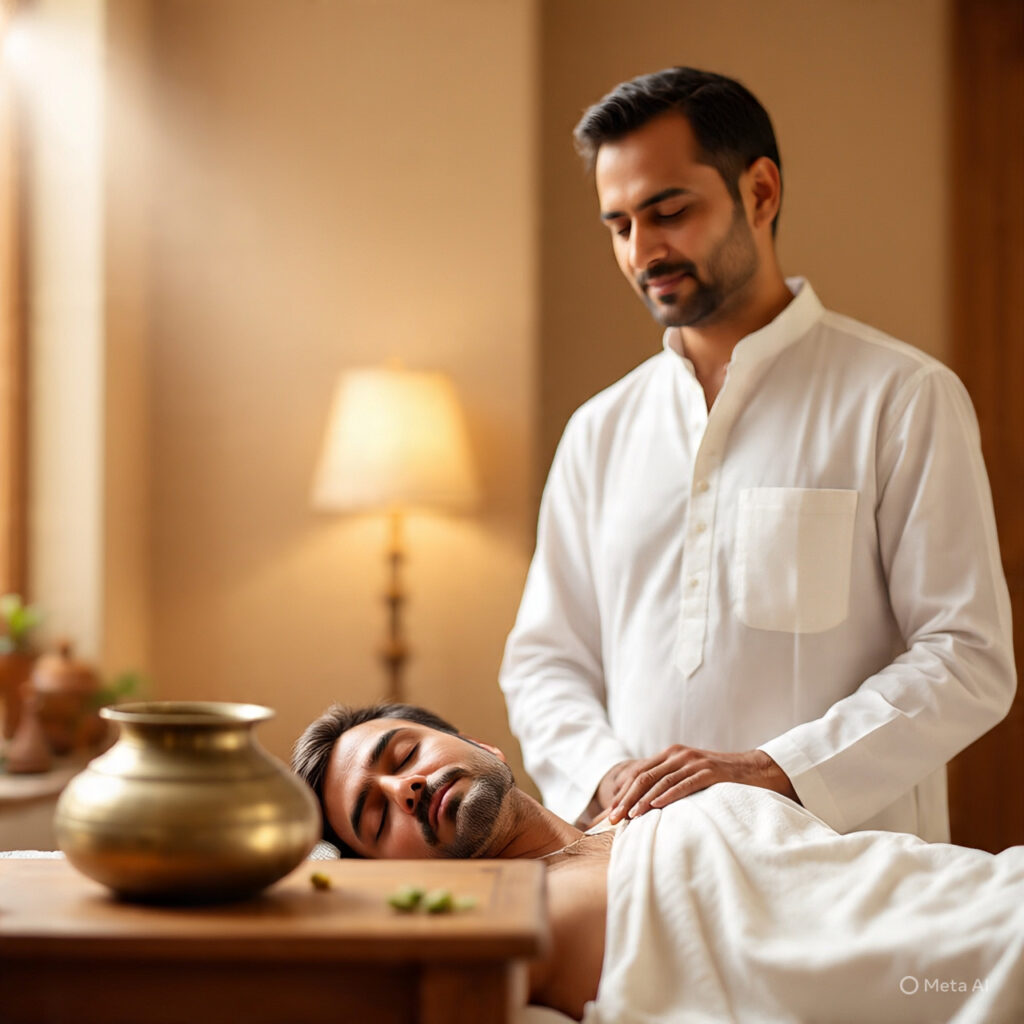Ayurveda: A Spiritual Science Beyond the Body

When most people think of Ayurveda, they imagine herbal medicines, oil massages, detox therapies, and dietary adjustments. While these are valid aspects, they represent only the surface—just a drop of the vast ocean that Ayurveda truly is. At its core, Ayurveda is not merely a system of physical healing; it is a deeply spiritual science. Its ultimate aim is not just to cure disease, but to restore harmony between the body, mind, and soul.
Health Is a Sacred Responsibility: Swasthavrutham and Aathuravrutham
Ayurveda outlines two foundational principles:
- Swasthavrutham – the art of maintaining health
- Aathuravrutham – the science of treating disease
To truly live a balanced and fulfilled life, one must align with the ethical and spiritual principles of Swasthavrutham. These aren’t just lifestyle tips—they are moral disciplines that protect your subtle realm and shape one’s karma.
The Ten Commandments of Swasthavrutham
Ayurveda classifies the causes of disease not just in terms of diet or climate, but as moral and spiritual lapses:
- Bodily Sins:
- Himsa (Cruelty)
- Stheyam (Stealing other’s Belongings)
- Anyatha Kaamam (Excessive Lust)
- Verbal Sins:
- Paishunam (Jealous Talk)
- Parusham (Rudeness)
- Anurtham (Speaking falsehoods or fabricated stories)
- Sambhinnaalaapam (Words that provoke quarrels or conflict)
- Mental Sins:
- Vyapadam (Wishing harm or danger upon others)
- Abhidya (Wicked or malicious desires)
- Drukviparyayam (Focusing only on negativity)
These subtle violations influence your nerve impulses which govern our accumulate over time and manifest as illness—not just in this life, but also due to karma from past births.
Illness as a Manifestation of Karma
“Aathuravrutham” acknowledges a profound truth:
“Poorva Janmakrutham Paapam Vyaadhi Roopena Jaayathe”
(Illnesses arise as manifestations of past karmic sins.)
Modern science looks for bacteria, viruses, or genetic mutations. Ayurveda looks deeper—into the mind, behavior, and even previous lifetimes. Disease isn’t just an imbalance in doshas—it is a sign that your body and soul are out of alignment with Dharma (natural law).
Healing as a Spiritual Process
Ayurveda’s treatment process goes far beyond symptom relief:
- Prakrutisthaapanam – Restore natural balance
- Praayaschitham / Paschathaapam – Atonement repenting and self-reflection
- Padhyam – Discipline and righteous living
- Nidaana Varjanam – Avoiding the root cause
- Shamanam – Pacification or Palliative therapy. a method of pacifying or calming the aggravated doshas
- Prashamanam – Symptom suppression
Among these, Oushadha Chikitsa (medicine-based treatment) is only a small component. Its application is categorized into:
- Hethu Vipareetham – Tackling the root cause
- Vyaadhi Vipareetham – Counteracting the disease
- Thadharthakaari – Managing symptoms
But without correcting the mental and spiritual disharmony, no medicine is truly effective.
The Sacred Role of the Vaidya
An Ayurvedic healer, or Vaidya, is not just a physician. He or she is a spiritual guide, a bridge between the patient’s pain and divine healing.
A true Vaidya:
- Understands the patient’s mental and emotional state
- Senses the subtle body imbalances (Sookshma & Sthoola Kaarana Shareera)
- Prescribes medicine based on Rasa (taste), Veerya (potency), and Vipaaka (post-digestive effect)
- Aligns the medicine with the patient’s inner receptivity
Healing truly begins when there is union—between the Vaidya, the medicine, and the patient.
Spiritual Healing through Parasparya (Mutual Resonance)
Ayurveda teaches that the healing process is divine when:
“Bhishagwara Bhaishajya Rogi Ethathra Samyojanam”
(The doctor, the medicine, and the patient unite.)
In the Sushupthi state (deep rest), the subconscious mind becomes receptive. An enlightened healer’s voice can plant seeds of positivity in this space. This:
- Instills hope in the patient
- Encourages emotional surrender and accept the situation without resistance
- Opens the body to healing responses
True recovery does not come only from herbs—it comes from acceptance, faith, and inner clarity.
The Deciding Factor: Time and Receptivity
In Ayurveda, no medicine is universally good or bad. The receptor state of the body decides whether something becomes:
- Amrutham (nectar) or
- Visham (poison)
A bitter herb can heal one person and harm another, depending on the time, mental state, and karma. The same applies to words, advice, and even silence.
Conclusion: Ayurveda is a Journey Back to the Soul
In an age obsessed with fast fixes, Ayurveda reminds us:
You are not a machine to be repaired—you are a soul seeking balance.
Illness is not the enemy—it is the messenger. Healing is not about curing—it is about reconnecting. And Ayurveda is not physical—it is profoundly spiritual.
“To heal the body, you must begin with the soul.”
~ Prem Krishnan
